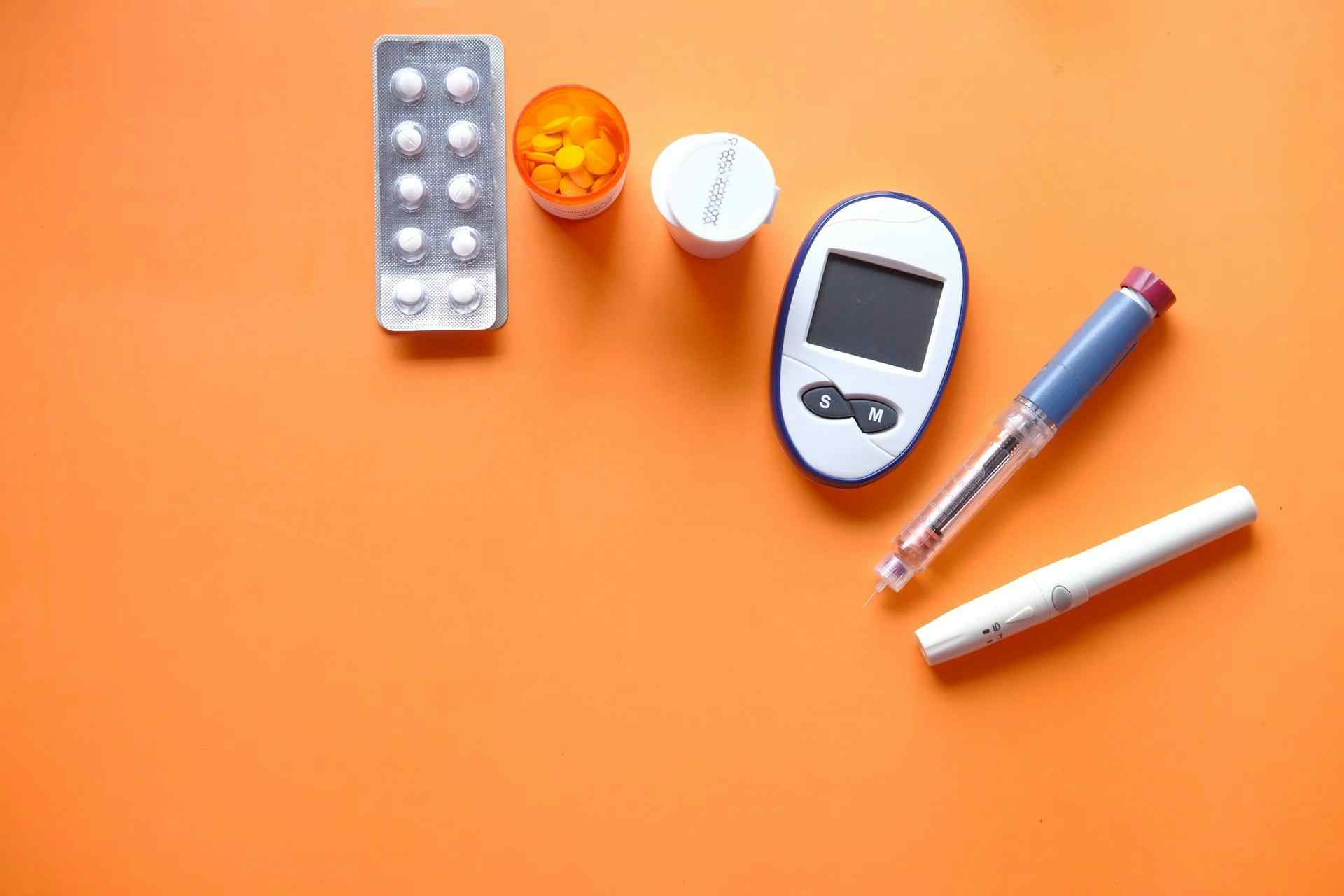Diabetes mellitus is the official name for the condition known as diabetes, and it is a common and potentially chronic disease that can be debilitating if not carefully managed. The common link between all types of diabetes is the presence of an excess of glucose in the bloodstream (sometimes called blood sugar). This results from the pancreas either not producing sufficient insulin or our body not reacting to the insulin appropriately.
Glucose is an essential component of cell respiration, the process that gives us the energy we use for everything. We get glucose from our diet through eating sugars and carbohydrates. The pancreas releases insulin, which breaks down complex sugars into simple glucose. Blood glucose levels are kept at manageable levels by the hormones insulin and glucagon that prevent too much blood glucose from building up.
Type 1 diabetes
In type 1 diabetes, the body cannot produce insulin, usually from the loss of insulin creating beta cells in the pancreas. Type 1 diabetes is typically diagnosed in childhood and only accounts for about 10% of global diabetes cases. A family history of type 1 diabetes is common among sufferers, although it is not hereditary.
Type 2 diabetes
In type 2 diabetes, the body initially develops insulin resistance, meaning the body stops responding to the insulin produced. This can lead to the body failing to produce enough insulin to reduce blood sugar levels as necessary. Type 2 diabetes has a much higher prevalence in adults and commonly results from a combination of poor diet and a lack of physical activity.
Other types of diabetes
The next most common form of diabetes is Gestational Diabetes, found in pregnant women. Gestational Diabetes often clears up after the child's birth but can also be an early warning of increased risk for future type 2 diabetes risk.
'Prediabetes' is a high level of blood sugar that is a likely indicator that someone is at increased risk of developing type 2 diabetes. When prediabetes is diagnosed, healthcare professionals strongly recommend lifestyle changes, including weight loss, physical activity, and diet changes, to avoid the risk of developing type 2 diabetes.
Symptoms of diabetes
While there are many symptoms of diabetes, not all will apply to everyone. Some common symptoms include:
- Frequent urination (particularly during the night)
- Feeling thirsty, even after having a drink
- Slower wound healing
- Blurry vision
- Feeling more tired than usual
- Thrush or genital itching
- Losing weight suddenly
If left untreated, the symptoms of diabetes can worsen rapidly. This can subsequently lead to kidney damage (including kidney failure), eye problems (including blindness) and problems with your feet, which in severe cases can require amputation.
Causes and risk factors
The primary risk of type 1 diabetes is your family history. The symptoms of type 1 diabetes are caused when the immune system attacks the cells responsible for insulin production, meaning that sugar builds up in your bloodstream.
The main risk of type 2 diabetes is being overweight, with obesity and high cholesterol highly linked to the development of type 2 diabetes. However, not all diabetes sufferers are obese and not all obese people have diabetes, though there is a high correlation. In women, polycystic ovary syndrome or previous incidence of gestational diabetes are both risk factors.
How does age influence diabetes?
Studies have suggested that age, particularly after 45, is a risk factor for type 2 diabetes. Diabetes.co.uk suggests that in the UK, type 2 diabetes typically presents in over 40s. But for those with South Asian and Afro-Caribbean ancestry, being over 25 is an increased risk indicator. Additionally, these figures can be further backed up by reports from the American Diabetes Association (ADA). The ADA also recommends screening tests for all people aged over 45.
Complications of diabetes
Several health problems and medical conditions can arise from having diabetes. These include:
Heart disease - This can include an increased risk of heart attack, stroke and cardiovascular disease due to poor function of the blood vessels after a build-up of high blood sugar.
Kidney disease - Also known as diabetic nephropathy. Estimates are that up to 40% of all kidney failure is related to diabetes. This is because the narrow blood vessels of the kidneys can become blocked or damaged by high blood sugar levels.
Neuropathy - This is a type of nerve damage caused by a build-up of sugars in the blood vessels and leading to numbness, tingling, and loss of sensation in the extremities.
Hypoglycemia - Often caused in reaction to diabetic medications or too much insulin being present, hypoglycemia is what happens when you have low blood sugar. Shaking, hunger, blurry vision, and confusion or irritability are the most common symptoms of hypoglycemia.
Diabetic Ketoacidosis (DKA) - In DKA, a severe shortage of insulin leads to the body being unable to use sugar for energy, so it tries to burn fat instead. This releases ketones, which can build up in the blood and become acidic. Being very thirsty and needing to urinate more, alongside tiredness, stomach pain, and confusion, are hallmarks of DKA.
Foot damage - Often a result of neuropathy combined with ulcers, sufferers of diabetes often develop numbness and ulcers of lesions on their feet. Unless carefully managed, this can lead to amputation in extreme cases.
Eye problems - Also known as diabetic retinopathy, this is where high blood sugar levels damage your retina. Thankfully, it usually takes years for this to escalate to a point where it threatens your sight. As such, you should have plenty of time to arrest this before it becomes significantly life-changing.
High Blood Pressure - High blood sugar can make it harder for your heart to pump blood around your body, particularly if combined with obesity or cholesterol, leading to high blood pressure that can cause hypertension and lead to cardiovascular disease.
Diabetes prevention
For type 1 diabetics, prevention is not possible. However, type 2 diabetes prevention remains a possibility and one that healthcare providers are keen to use before going down a more medicalised route. Since there are early indicators (see 'prediabetes' above) of developing type 2 diabetes, it is entirely possible to prevent the condition from developing. Doctors believe that more than half of all cases of type 2 diabetes could be prevented. Increased exercise, decreased body weight, and changing dietary habits are the most effective ways to prevent prediabetes from becoming type 2 diabetes.
Diabetes treatment
Once diabetes has been diagnosed, usually through glucose monitoring and a glucose tolerance test, treatment can begin. In many cases, the first steps in treatment will be diet and exercise based, aiming to change the habits that have led to the development of diabetes, at least in type 2 cases.
Type 1 diabetics will usually be given insulin to help them manage their diabetes. This can be in the form of individual insulin injections or an insulin pump. The pump is more effective at managing diabetes for many, although it is not available as widely as insulin injections.
Type 2 diabetics who have not been able to manage their diabetes with exercise and diet may also be prescribed insulin. UK Diabetics get free insulin and other diabetes medication prescriptions on the NHS. Some may also be prescribed metformin, an oral tablet that helps manage your insulin use.
Paul from Diabetic Dad told us: "Living with Diabetes, specifically Type 1 Diabetes in my case, can be challenging to say the least. The great news is that as time has passed, the treatments and technologies to help manage the condition have advanced to lift some of the burden of living with Type 1 Diabetes.
"In the UK, access to those technologies is greater than ever and with the emergence of peer support networks such as GBDOC (Great Britain Diabetes Online Community) there is always help at hand from people living with the condition."
Diabetes care
Diabetes care can be very wide-ranging and may involve input from doctors, specialist nurses, dietitians, nutritionists, personal trainers, podiatrists and chiropodists, to name just a few. In addition, the NHS and the American Diabetes Association have a lot of advice available on how to help manage your own diabetes care or that of a loved one.
Curing diabetes
For type 1 diabetes, there is no known cure. As a genetic condition, it is likely to be a lifelong illness. Type 2 diabetes has been shown to go into remission and is almost always reduced by changing dietary and lifestyle plans.
The good news is that you don't have to completely cut out sugar or carbohydrates. Often, a simple reduction in the amounts and frequency of 'treats' can have a considerable impact. Weight loss and sugar reduction have led to the complete remission of symptoms in some patients. So talk to your doctor about small changes you can make to your diet.
Improving your exercise habits can also play a huge part in weight loss and symptom reduction. Even going for a 10-minute walk each day can be an excellent start to reducing the impact and effect of your diabetes symptoms.
Dealing with diabetes in later life
Many people will face the possibility of type 2 diabetes later in their lives, and age is a contributing factor. However, in most cases, it is possible to continue to live a long and happy life. Self-care by managing your diet and exercise is vital to maintaining good health. Visiting your doctor at the earliest sign of diabetes symptoms is the best way to ensure that the condition can be dealt with quickly. Medical intervention through insulin or drugs such as metformin can be avoided altogether but should not be seen as a weakness if they become necessary.
5 ways older people can manage their diabetes
- Eating healthily - a healthy diet low in sugar and saturated fats can help prevent spikes in your blood glucose and allow you to manage your diabetes well. In fact, studies suggest that diet and lifestyle modifications alone can even reverse type 2 diabetes!
- Staying active - we may not be as dextrous and flexible in our older age. However, we can still carry out certain activities to help keep us fit and healthy. Examples of exercises you can do to help keep the weight off include swimming, walking, hiking, or, if you're feeling adventurous, Zumba.
- Improve compliance - adhering to your medication schedule is essential in managing your diabetes, whether type 1 or type 2. Luckily, there are various methods you can use to help you remember to take your medication, for example, using a pillbox or asking your pharmacist to make you one, setting phone alarms, or, if you're old-school, using a written chart.
- Test your blood pressure and cholesterol - cardiac components including cholesterol and blood pressure are significant risk factors of type 2 diabetes. By getting these regularly checked by your healthcare professional, you can reduce your risk of disease progression and further complications.
- Get your feet checked - one of the most common symptoms of progressed type 2 diabetes is peripheral neuropathy - or, in other words, numbness. This commonly affects the feet, and so many diabetes are often left with ulcers or injuries to their feet without notice which can quickly turn nasty. So check your feet daily and even arrange to see a podiatrist regularly to keep you in check.






